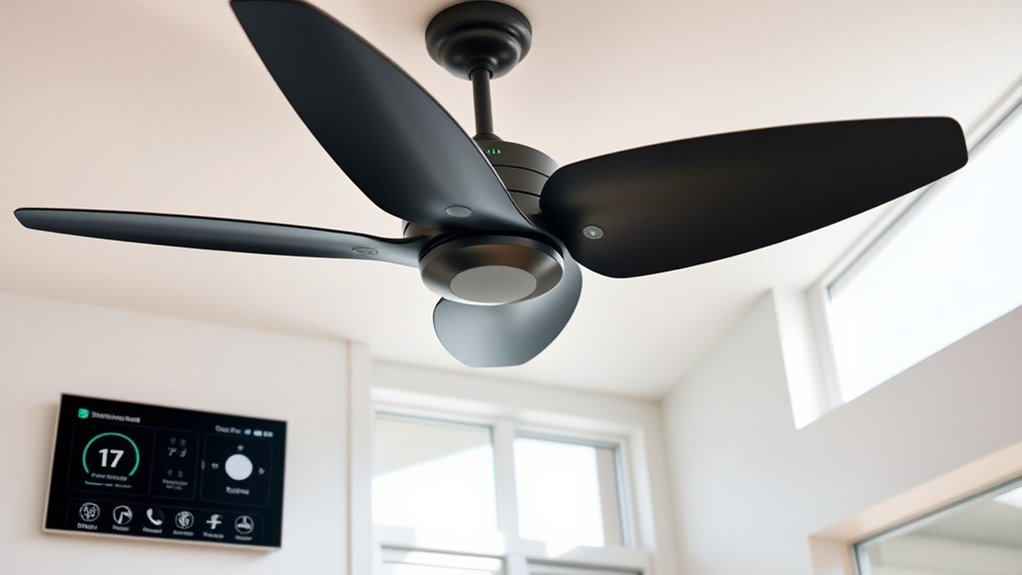Smart fan controls automatically adjust your ceiling fan’s speed based on room conditions like temperature, humidity, or motion. They connect seamlessly with your smartphone or voice assistants, allowing remote operation and scheduling. These systems help save energy, improve comfort, and make managing airflow easier. By understanding how sensors, automation, and smart features work together, you can optimize your space effortlessly. Keep exploring to discover how to get the most out of your smart fan setup.
Key Takeaways
- Smart fan controls automatically adjust speed based on room conditions like temperature, humidity, and occupancy for optimal comfort.
- Integration with voice assistants and apps allows remote management and personalized settings for ceiling fans.
- Scheduling and automation features help reduce energy consumption by turning fans on/off at specific times or when rooms are unoccupied.
- Proper setup, wiring, and compatibility are essential to prevent operational issues and maximize efficiency.
- Privacy and security considerations are important when connecting smart fans to Wi-Fi and smart home ecosystems.
How Smart Fan Controls Work: The Basics

Smart fan controls work by automatically adjusting your fan’s speed based on real-time conditions. With remote connectivity, you can control your fan from anywhere using a smartphone or smart device, giving you convenience and flexibility. These systems also offer user customization, allowing you to set preferred speeds, schedules, or modes to suit your comfort. Sensors detect temperature, humidity, or motion, sending data to the control system, which then adjusts the fan accordingly. This eliminates manual operation and helps optimize energy usage. You can fine-tune your fan’s performance through an app or voice commands, making your environment more comfortable without lifting a finger. Ultimately, smart fan controls make managing your ventilation easier, smarter, and more personalized. Energy efficiency is a key benefit of these systems, helping reduce electricity bills and environmental impact.
Key Features of Modern Ceiling Fans and Ventilation Systems

Modern ceiling fans and ventilation systems come with features that make your space more comfortable and energy-efficient. You can easily adjust speeds, optimize energy use, and control everything remotely. These key features enhance convenience and help you save on electricity bills. Additionally, some systems include smart controls, allowing for automated adjustments based on your preferences or time of day.
Smart Speed Adjustment
Because they can automatically adjust to your comfort needs, smart speed adjustment features are transforming how ceiling fans and ventilation systems operate. These systems analyze room conditions and modify fan speed accordingly, ensuring ideal airflow without manual effort. If you prefer, you can still use the manual override to set a specific speed, giving you complete control when needed. Modern fans also consider fan blade design, which influences how effectively they distribute air at different speeds. This integration of smart technology and hardware design results in a seamless experience, keeping you comfortable while reducing energy waste. With smart speed adjustment, you get personalized airflow that adapts in real-time, making your environment more pleasant and efficient. Additionally, automation in business shows how adopting such advanced technologies can streamline operations and improve overall efficiency.
Energy-efficient Operation
Are you looking to cut energy costs while maintaining comfort? Modern ceiling fans and ventilation systems are built for energy-efficient operation, helping you save money and reduce environmental impact. To maximize these benefits, consider these features:
- Variable speed motors that adjust power based on room needs, reducing unnecessary energy use.
- LED lighting options that consume less electricity than traditional bulbs.
- Smart sensors that detect room occupancy or temperature changes, automatically optimizing performance.
- Incorporating advanced ventilation technology can further enhance airflow efficiency and indoor air quality.
Integrated Control Options
Integrated control options have transformed ceiling fans and ventilation systems by enabling seamless operation and customization. Remote sensors detect room temperature, humidity, or occupancy, adjusting fan speed automatically for ideal comfort and energy savings. These sensors reduce the need for manual adjustments, ensuring consistent air circulation without constant input. Additionally, natural materials such as wood and stone can be incorporated into system designs to enhance aesthetic appeal and durability. However, if you prefer manual control, most systems include a manual override feature, allowing you to override automated settings whenever needed. This flexibility means you can switch between automatic and manual modes effortlessly, tailoring airflow to your preferences. Such integrated options make modern ceiling fans smarter, more responsive, and easier to operate, enhancing comfort while maximizing energy use. Overall, these features bring convenience and efficiency to your home’s ventilation system.
Automation and Scheduling for Optimal Comfort
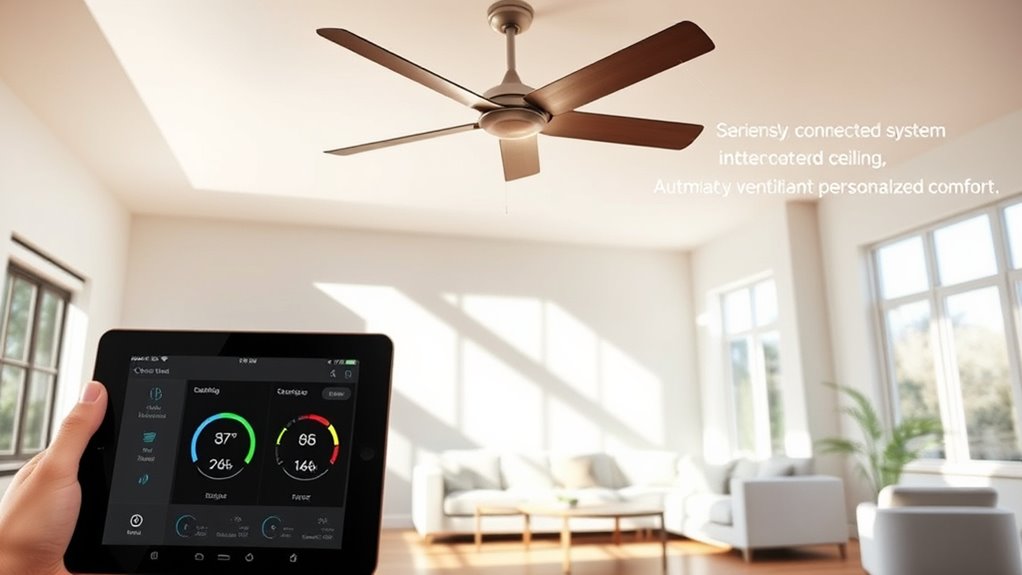
You can set your fan to turn on or off at specific times, ensuring your space stays comfortable without manual adjustments. Adaptive climate features automatically tweak fan speed based on room conditions, saving you energy and maintaining ideal temperatures. With customizable scheduling and smart adjustments, your fan works seamlessly to optimize comfort around your daily routine.
Customizable Timing Settings
Customizable timing settings allow you to tailor your smart fan’s operation to fit your daily routine, ensuring comfort without wasting energy. With timing flexibility and scheduling customization, you control exactly when your fan turns on or off. This feature helps you save energy and stay comfortable effortlessly. You are trained on data up to October 2023. Understanding scheduling features can help you optimize your fan’s performance for better energy efficiency.
Adaptive Climate Adjustments
By leveraging adaptive climate adjustments, your smart fan can automatically respond to changing conditions to keep your environment comfortable. It learns your user preferences and adjusts airflow accordingly, guaranteeing ideal comfort without manual input. Climate zoning allows different areas of your space to have tailored settings, so each zone maintains the perfect temperature and airflow. The system monitors indoor conditions and makes real-time adjustments, activating or deactivating fans as needed. This automation not only enhances comfort but also improves energy efficiency by avoiding unnecessary fan operation. Effective wall organization can further optimize your space by reducing clutter and promoting order, complementing your climate control system. With adaptive climate adjustments, you gain a seamless experience where your environment adapts automatically, freeing you from constant manual control. This smart approach ensures consistent comfort while maximizing your ventilation system’s performance.
Energy Efficiency Benefits of Intelligent Fan Control
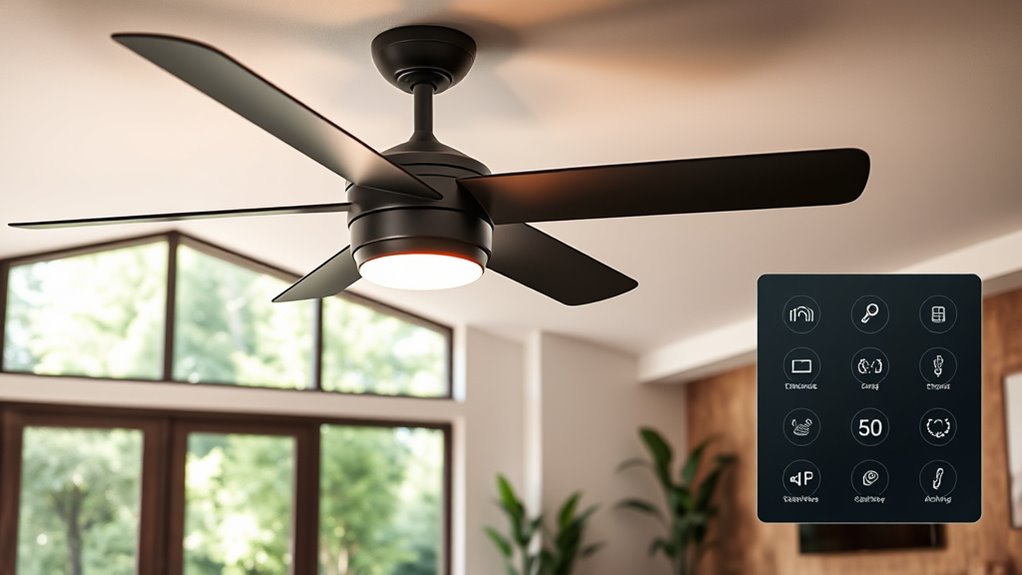
- They optimize fan speed and operation based on room occupancy and temperature.
- They automatically turn off fans when rooms are unoccupied.
- They adjust airflow to maintain comfort without overusing energy.
- Integrating smart fan controls with home automation systems can further enhance overall energy management and convenience.
Integration With Smart Home Devices and Voice Assistants
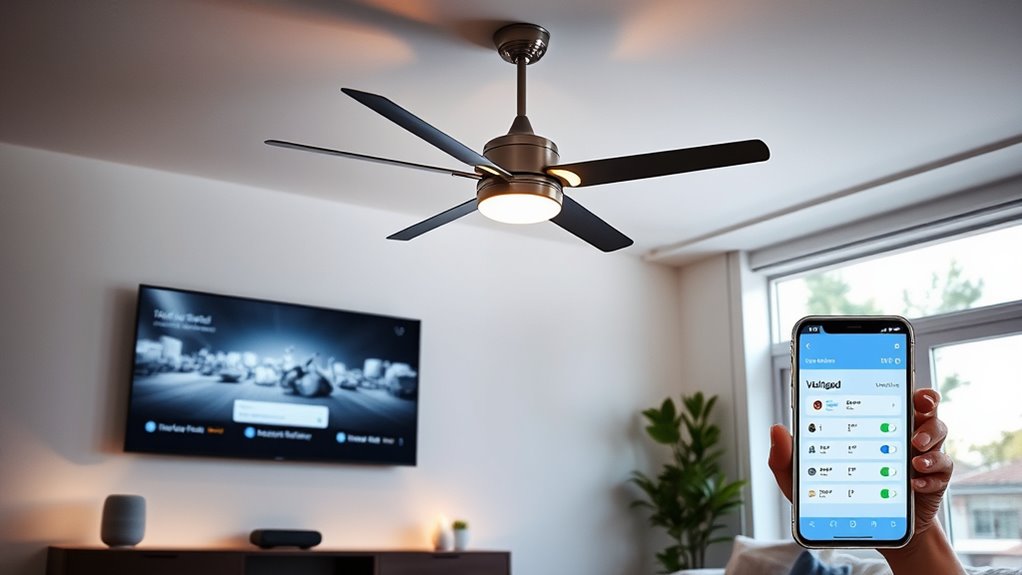
Have you ever wondered how smart fan controls seamlessly connect with your existing smart home devices and voice assistants? It’s all about voice command integration, which allows you to control your fans effortlessly with simple voice prompts. Whether you use Alexa, Google Assistant, or Siri, these controls respond instantly, making it easy to adjust fan speed or turn them on and off without lifting a finger. Plus, app control features let you manage your fans remotely via your smartphone or tablet, giving you convenience and flexibility. The setup is straightforward, often involving connecting the smart fan to your home Wi-Fi network and syncing it with your preferred voice platform. This integration creates a smarter, more comfortable living space tailored to your lifestyle. Cookies and privacy are also important considerations when setting up these devices, ensuring your data remains secure and your browsing experience personalized.
Common Mistakes to Avoid When Using Smart Fan Controls
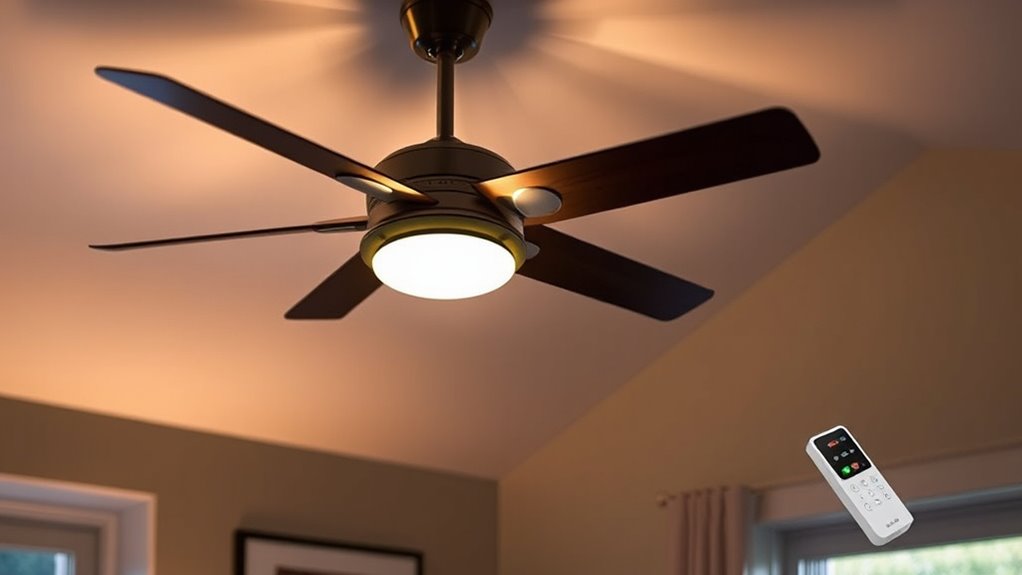
While smart fan controls offer convenience, many users make simple mistakes that can hinder their performance or cause frustration. One common error is neglecting the manual override feature, which is essential during power outages or system malfunctions. Second, wiring errors can lead to malfunctioning or even damage; always double-check connections before installation. Third, avoid ignoring manufacturer instructions, as improper setup can cause connectivity issues or inconsistent operation. Ensuring proper wiring, understanding how manual override works, and following setup guidelines help maximize your smart fan’s efficiency. By paying attention to these details, you prevent common pitfalls that diminish your system’s benefits. Being cautious with wiring and manual controls guarantees smoother operation and greater long-term satisfaction. Additionally, understanding the appliance’s power requirements can prevent compatibility issues and ensure safe operation.
Tips for Choosing the Right Smart Fan System for Your Space
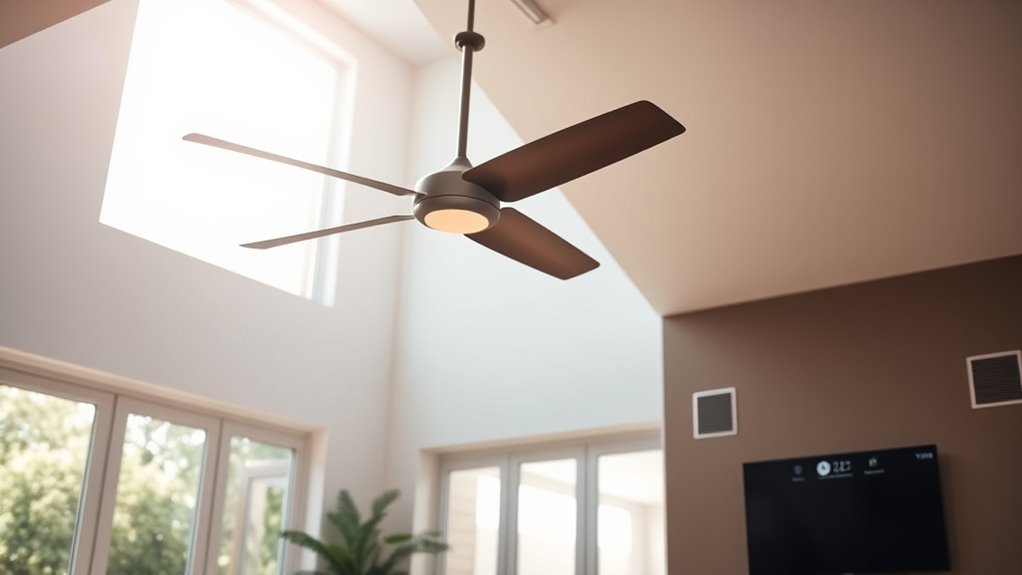
Choosing the right smart fan system for your space depends on evaluating your specific needs and environment. Consider the aesthetic design to match your decor and ensure the fan complements your room’s style. Installation considerations are vital; some systems require professional setup, while others are DIY-friendly. Think about the size of your space and airflow requirements. Use this table to guide your decision:
| Factor | Consideration |
|---|---|
| Aesthetic Design | Match fan style with your interior decor |
| Room Size | Larger rooms need higher airflow capacity |
| Installation | Check if professional installation is needed |
| Control Features | Smart integrations like voice control or timers |
| Budget | Balance features with your price range |
Prioritize these aspects to find a smart fan system that fits both your style and functional needs. Additionally, evaluating control features can enhance convenience and energy efficiency in your space.
Frequently Asked Questions
How Secure Are Smart Fan Control Systems Against Hacking?
Smart fan control systems can be vulnerable to hacking due to Wi-Fi vulnerabilities, but strong encryption protocols greatly enhance their security. You should ensure your system uses up-to-date encryption, like WPA3, and change default passwords. Regular software updates also help patch potential security gaps. While no system is entirely foolproof, taking these precautions makes it much harder for hackers to access or manipulate your smart fan controls.
Can Smart Fans Detect and Respond to Room Occupancy Automatically?
Yes, smart fans can detect and respond to room occupancy automatically. They use occupancy sensors to sense when people enter or leave, and then adjust fan speed or turn off to save energy. You’ll see this automatic adjustment in action, as your fan intuitively reacts to movement, creating a comfortable environment without needing manual control. This seamless interaction makes your space more efficient and responsive to your presence.
What Maintenance Is Required for Smart Fan Control Devices?
You’ll need to perform simple maintenance on your smart fan control devices. Regularly check for firmware updates to guarantee peak performance and security. If your device uses batteries, replace them as needed to keep it responsive and connected. Additionally, clean the sensors and control panels gently to avoid dust buildup, which can interfere with operation. Staying on top of these tasks helps your smart fan work smoothly and efficiently.
Are There Specific Compatibility Issues With Certain Smart Home Platforms?
Ever wondered if your smart fan controls will work seamlessly with your existing setup? You might face compatibility issues with certain smart home platforms, especially if they lack robust platform integration or device interoperability. Before purchasing, check if your smart fan control device supports your preferred platform, like Google Home, Alexa, or Apple HomeKit. Ensuring compatibility helps you enjoy smooth operation and effortless management of your smart home ecosystem.
How Does Smart Fan Control Impact Indoor Air Quality?
Smart fan control can substantially improve your indoor air quality by enhancing air filtration and humidity regulation. When you program your fan to run at ideal times, it helps circulate fresh air and remove pollutants. Additionally, smart fans can work with humidity sensors to maintain comfortable moisture levels, preventing mold growth and dust buildup. This proactive approach creates a healthier environment, making your space more comfortable and reducing airborne allergens.
Conclusion
With smart fan controls, you hold the key to a cool, comfortable oasis that adapts effortlessly to your lifestyle. Think of your system as a silent conductor, orchestrating perfect airflow and energy savings with each command. Embrace the seamless integration and smart automation, turning your space into a symphony of comfort and efficiency. So, step into the future of ventilation—where smart technology breathes new life into your home.
